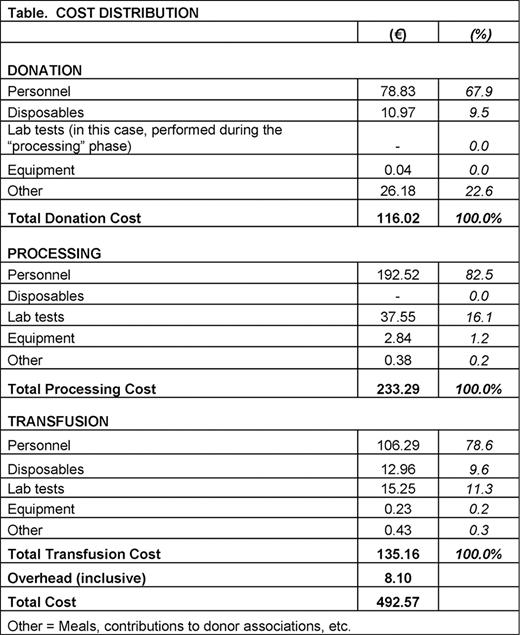Abstract
Abstract 3817
For the majority of patients (pts) with myelodysplastic syndromes (MDS), anemia is the principal cause of symptoms. Red blood cell (RBC) transfusion can alleviate fatigue, dyspnea, and cardiac problems in anemic pts. Approximately 80% of pts with MDS are anemic at the time of presentation and more than 40% require regular RBC transfusions at some stage of disease (Brechignac, Blood, 2004;A4716). Cost of blood products is one of the most uncontrollable items in the budget of MDS care.
This study was performed to identify, measure, and assess the health care activities and resources needed to provide RBC transfusions, and to determine their costs.
This cost analysis was performed from the perspective of health care providers, according to the Activity Based Costing (ABC) method (Asadi, J Soc Health Syst,1996). ABC systems focus on activities involved in the delivery of care. Under the ABC system, costs are first traced to activities and then traced from the activities to units of episodic care using cost drivers based on the consumption of activity resources (Udpa, Manag Care Q, 2001). This analysis was performed within Florence Italy's Local Health Authority (ASL 10; 813,419 members, 48% male, 2008), at OSMA Transfusion Center, with scientific support from the Hematology Unit of AOU Careggi University Hospital, Florence. All transfusions were performed in an outpatient ambulatory setting and no hospitalizations (for any cause) were considered in the analysis. A “self-reporting” approach (Burke, J Nurse Admin, 2000) was used to collect resource utilization data. According to the ABC method, the transfusion procedure was described in terms of episodes that encompass macro-activities and micro-activities (Casati, McGraw-Hill, 2002) and are represented in a process-flow diagram. All professionals involved in providing RBC transfusions participated in structured interviews and validated the flow chart generated to represent the process. Human, material, and capital resources were described, and their unitary costs provided by the OSMA Cost and Performance Management Office, for the year 2008. Episodes identified were: RBC donation, processing, and transfusion, each subdivided into macro-activities and micro-activities amenable to economic assessment. Macro-activities identified for donation included: admission, clinic visit, donation, and discharge; for processing: centrifugation, separation of blood elements, and storage; and for transfusion: pt admission, compatibility testing, distribution, transfusion, and waste management. Micro-activities were evaluated according to the professional who performed the task and the time and materials required. Unit costs were attributed to resources as follows:
The total average cost of the 3 episodes for RBC transfusion was |CE492.57, divided as follows: 1) donation: |CE116.02; 2) processing |CE233.29; 3) transfusion |CE135.16, and 4) overhead |CE8.10. Cost distribution is shown in the Table. The cost of a single RBC unit was |CE349.31. OSMA-Florence Transfusion Center managed 7,994 RBC units in 2008, from which the Hematology section performed an average of 23 transfusions per week (4.6 per day).
RBC transfusion is an essential and life-saving intervention for anemic patients. The economic burden of transfusions comprises 2 dimensions: costs to perform transfusion and costs associated with management of transfusion-related risks (eg, iron overload, transmitted infections, adverse effects attributable to immune mechanisms) (Alessandrino, Blood, 2002). Our analysis quantitates costs for the first dimension, providing direct and indirect costs of RBC transfusion.
| Labor | Average cost/minute per personnel category |
| Disposables | Acquisition costs |
| Lab tests | Costs incurred by the Unit for labor, materials, plant, building, equipment, etc., to perform tests |
| Equipment | Leasing costs, accruals |
| Other costs | Meals, contributions to donor associations |
| Overhead | Assigned on a square-meter basis |
| Labor | Average cost/minute per personnel category |
| Disposables | Acquisition costs |
| Lab tests | Costs incurred by the Unit for labor, materials, plant, building, equipment, etc., to perform tests |
| Equipment | Leasing costs, accruals |
| Other costs | Meals, contributions to donor associations |
| Overhead | Assigned on a square-meter basis |
No relevant conflicts of interest to declare.
Author notes
Asterisk with author names denotes non-ASH members.


This feature is available to Subscribers Only
Sign In or Create an Account Close Modal